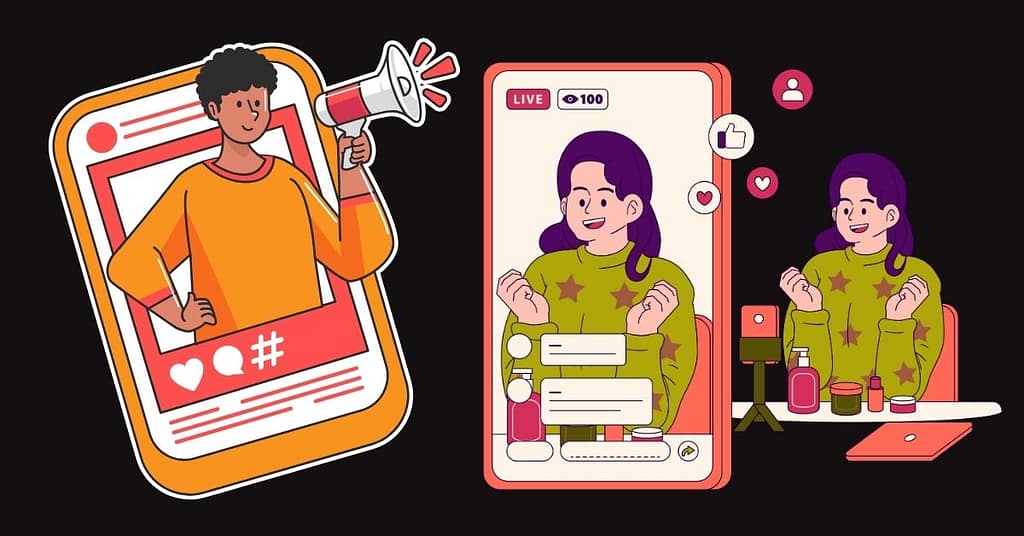Campaign Strategy | Social Media Outreach | ROI Tracking | Digital Marketing | Micro- Influencer
Summary
Master micro-influencer marketing for D2C brands with proven tactics that create authentic connections, 7% engagement rates, and $5.78 return for every dollar spent.
Table of Contents
Traditional Influencer Marketing with celebrity endorsements continues to command attention, savvy marketers are increasingly turning to micro-influencer marketing to drive authentic engagement and sustainable growth for niche D2C products.
Recent data shows just how powerful this approach can be: according to a 2024 Influencer Marketing Hub report, micro-influencer campaigns generate an average of $5.78 for every $1 spent, compared to $4.87 for campaigns with larger influencers. Additionally, micro-influencers boast engagement rates of 7% on average—nearly triple the 2.4% engagement rate of mega-influencers.
As the Head of Digital Marketing at a leading agency, I’ve guided dozens of niche D2C brands through the process of developing effective micro-influencer strategies. In this comprehensive guide, I’ll share actionable insights, step-by-step processes, and proven templates to help you implement micro-influencer marketing for your brand’s growth.
What Makes Micro-Influencer Marketing So Effective for D2C Brands?
Before diving into the how-to section, let’s understand why micro-influencer marketing works so well for niche D2C brands:
- Higher Engagement Rates: Micro-influencers (typically defined as having 10,000-50,000 followers) maintain closer connections with their audiences. According to Upfluence’s 2024 data, micro-influencers on Instagram achieve 60% higher engagement rates than larger influencers.
- Authentic Trust: A 2023 consumer trust survey from Edelman found that 82% of consumers trust recommendations from micro-influencers more than traditional advertisements, viewing their endorsements as genuine personal recommendations rather than paid promotions.
- Cost-Effectiveness: With average collaboration costs ranging from $100-$500 per post (versus $10,000+ for celebrity influencers), micro-influencer campaigns allow D2C brands to work with multiple content creators across different niches while maintaining reasonable marketing budgets.
- Targeted Reach: Micro-influencers often build their following around specific interests, giving D2C brands access to highly relevant audience segments that align perfectly with niche products.
Toolkit to Launch Your Micro-Influencer Campaign
1. Define Clear Campaign Objectives and KPIs
Before reaching out to a single influencer, establish what success looks like for your campaign:
- Brand awareness goals (follower growth, content reach)
- Engagement metrics (likes, comments, shares, saved posts)
- Conversion targets (click-through rates, sign-ups, sales)
- Content generation goals (UGC volume, testimonials)
Pro Tip: Set SMART goals (Specific, Measurable, Achievable, Relevant, Time-bound) for each campaign. For example: “Increase website traffic from Instagram by 30% in the next 90 days through strategic micro-influencer partnerships.”
2. Identify Your Ideal Micro-Influencer Profile
Not all micro-influencers will be right for your brand. Create a detailed profile of your ideal partner by considering:
- Audience Demographics: Age, location, gender, income level
- Niche Relevance: How closely their content aligns with your product category
- Content Quality: Production value and aesthetic compatibility with your brand
- Engagement Quality: The nature of comments and interactions (genuine vs. superficial)
- Values Alignment: How well their personal brand values match yours
According to a 2024 Influencer Intelligence report, audience alignment is the single most important factor for campaign success, with relevance driving 3.7x higher conversion rates than follower count alone.
3. Find and Vet Potential Micro-Influencers
Here are several effective methods for discovering suitable micro-influencers:
Tools and Platforms:
- Upfluence
- CreatorIQ
- Grin
- Klear
- AspireIQ
Manual Research Methods:
- Explore relevant hashtags within your niche
- Check who’s engaging with competitor brands
- Review your existing followers and customers (often your best advocates)
- Ask for recommendations from industry partners
Vetting Process:
- Analyze engagement-to-follower ratios (look for 2-8% on Instagram, 1-5% on TikTok)
- Verify audience authenticity (check for suspicious growth patterns or bot-like engagement)
- Review content consistency and quality over the past 3-6 months
- Examine past brand collaborations for authenticity and alignment
4. Develop a Compelling Outreach Strategy
Cold DMs rarely yield results. Here’s how to make your outreach stand out:
Personalized Engagement:
- Follow potential partners several weeks before outreach
- Engage meaningfully with their content (thoughtful comments, not just emojis)
- Share their content in your stories with genuine appreciation
Outreach Template:
Hi [Name],
I’m [Your Name] from [Your Brand]. I’ve been following your content for a while and particularly loved your recent [specific post] because [genuine reason].
We’re launching a new [product type] designed for [specific audience/need], and your authentic approach to [relevant topic] made me think you’d be a perfect partner.
Would you be open to discussing a potential collaboration? We’d love to send you our [product] to experience firsthand.
Looking forward to hearing from you!
[Your Name]
Follow-Up Strategy:
- Wait 5-7 days before a gentle follow-up
- Provide a clear, non-pushy call to action
- Make it easy to say yes with minimal initial commitment
5. Structure Mutually Beneficial Collaboration Terms
The most successful micro-influencer partnerships create value for all parties:
Compensation Options:
- Product-only exchanges (most effective for products valued at $100+)
- Flat-rate payment per content piece
- Hybrid models (smaller payment + product)
- Affiliate or commission structures (using trackable links)
- Long-term ambassador relationships with recurring benefits
According to Influence.co’s 2024 compensation survey, the average micro-influencer rates are:
- Instagram: $150-400 per post
- TikTok: $200-500 per video
- YouTube: $300-700 per video mention
- Blog post: $350-800 per article
Contract Essentials:
- Clear deliverable specifications (content type, quantity, posting schedule)
- Content rights and usage permissions
- Exclusivity terms (if applicable)
- FTC compliance requirements
- Performance expectations
- Payment terms and conditions
6. Brief Influencers Well Without Sacrificing Authenticity
The briefing stage is critical for balancing brand messaging with authentic creator expression:
Effective Brief Components:
- Brand background and values
- Product details and key benefits
- Target audience insights
- Campaign objectives
- Content guidelines (do’s and don’ts)
- Required hashtags, tags, and links
- Inspiration examples
Authenticity Preservation Tactics:
- Provide key messaging points rather than rigid scripts
- Ask for their input on how to best present your product to their audience
- Share what has worked in past campaigns without demanding replication
- Allow creative freedom within broad guidelines
7. Implement Robust Tracking and Measurement Systems
To accurately measure ROI and campaign effectiveness:
Essential Tracking Methods:
- Unique discount codes per influencer
- Custom UTM parameters for link tracking
- Affiliate/referral links
- Instagram shopping tags
- Post engagement analytics
- Before/after metrics for key KPIs
Reporting Dashboard Example:
| Influencer | Followers | Reach | Engagement | Link Clicks | Conversions | Revenue | ROI |
| @username1 | 25K | 8.2K | 6.50% | 342 | 28 | $1,960 | 3.9x |
| @username2 | 18K | 5.5K | 7.80% | 283 | 32 | $2,240 | 4.5x |
8. Nurture Long-Term Relationships for Sustained Growth
The real power of micro-influencer marketing comes from ongoing partnerships:
Relationship Building Strategies:
- Send personalized thank-you notes after campaigns
- Provide early access to new products
- Feature influencers in your own brand content
- Offer increasing benefits for continued collaboration
- Create exclusive experiences for your influencer network
According to a 2024 study by Later, repeat collaborations with the same micro-influencers show a 34% higher conversion rate than first-time partnerships.
How a Niche Skincare Brand Achieved 215% Growth Through Micro-Influencer Marketing
Let me share a recent success story from one of our agency clients:
Brand: Botaniq (premium natural skincare for sensitive skin) Challenge: Limited marketing budget, highly competitive market Solution: Targeted micro-influencer campaign focusing on skincare enthusiasts with dedicated followings in the clean beauty space
Campaign Structure:
- 25 micro-influencers with 15K-40K followers
- 3-month campaign with consistent posting schedule
- Product-plus-payment compensation model
- Content focus on educational skincare routines featuring Botaniq products
- Custom tracking links for attribution
Results:
- 215% increase in direct sales over the campaign period
- 178% growth in Instagram following
- 4.8x ROI on campaign investment
- 27 pieces of high-quality UGC for repurposing
- 3 micro-influencers converted to long-term brand ambassadors
Key Learning: The most successful content wasn’t the most professionally produced but rather the most authentic before-and-after demonstrations showing real results.
Common Pitfalls to Avoid in Micro-Influencer Campaigns
Even well-planned campaigns can falter. Here are the most common mistakes to avoid:
- Prioritizing Follower Count Over Engagement: A micro-influencer with 15K highly engaged followers will usually outperform one with 50K passive followers.
- Micromanaging Content Creation: Too much control diminishes authenticity—the very quality that makes micro-influencers effective.
- One-Off Campaigns: Short-term thinking leads to transactional relationships rather than building valuable long-term partnerships.
- Neglecting FTC Compliance: Ensure all sponsored content is properly disclosed to avoid regulatory issues.
- Poor Tracking Implementation: Without proper attribution, you can’t accurately measure campaign effectiveness or optimize future efforts.
Advanced Strategies for 2025 and Beyond
As micro-influencer marketing evolves, these emerging tactics are showing promising results:
Micro-Influencer Content Syndication
Repurpose high-performing influencer content across your owned channels and paid ads. According to WordStream, ads featuring influencer content see 31% higher click-through rates than brand-created content.
Community-Building Approach
Instead of working with influencers individually, create a community of micro-influencers who interact with each other while promoting your brand, creating an ecosystem of authentic advocacy.
Micro-Influencer Live Shopping Events
Coordinate simultaneous live shopping events across multiple micro-influencer accounts, creating a shopping festival atmosphere around new product launches.
AI-Powered Influencer Matching
Utilize new AI tools like Influential’s match.ai and CreatorIQ’s Creator Intelligence to identify ideal partners based on audience psychographic alignment rather than just demographic overlap.
Values-Based Campaigns
Focus campaigns on shared values rather than product features. A 2024 Sprout Social study found that value-aligned content generates 72% higher engagement than purely product-focused content.
Future Belongs to Authentic Connections
As digital marketing continues to evolve, the power of genuine human connections only grows stronger. Micro-influencer marketing represents the perfect balance between scalable digital strategy and authentic relationship building.
For niche D2C brands looking to grow sustainably, micro-influencer campaigns offer an unmatched combination of targeted reach, cost efficiency, and conversion potential. By following the strategies outlined in this guide, you’ll be well-positioned to harness the power of these authentic voices to connect meaningfully with your ideal customers.
Remember that successful micro-influencer marketing isn’t about quick wins—it’s about building a network of genuine brand advocates who can grow alongside you. Start small, measure carefully, and scale what works.
What micro-influencer strategies have worked for your brand? Share your experiences in the comments below, or reach out directly if you need guidance on developing your own micro-influencer campaign strategy.
Further Resources to Explore







